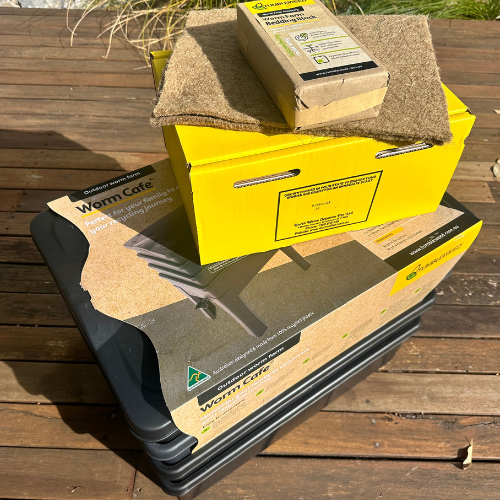In our kitchen, scraps are a daily rhythm. Juice pulp, fruit peels, apple cores, and the never-ending crusts left behind by little hands. For the longest time, those scraps went straight into the bin. But recently, we decided to give them a better home in a worm café.
We brought home the Tumbleweed Worm Café from Bunnings, and the kids got involved in setting it up (they actually did the whole thing!). The kids unpacked the trays, helped soak the bedding block, and were fascinated when we revealed the box of 1,000 worms. It's an ongoing family project, one that's teaching us about cycles, soil, and how nothing in nature is wasted.
Why worms?
Worms are nature’s quiet workers. They munch their way through scraps and transform them into two magical things:
-
Worm castings - nutrient-rich soil that can be sprinkled into garden beds or pots.
-
Worm liquid (or “worm tea”) - a dark, nutrient-dense fertiliser that plants absolutely love.
This liquid is collected via a tap at the bottom of the worm café, and when diluted with water, it becomes the perfect tonic for our veggie patch. Tomatoes, herbs, leafy greens - they all thrive with a little splash of worm juice.
Why we love it
-
It cuts down on food waste going into landfill.
When food scraps end up in landfill, they don’t break down the same way they do in healthy soil. Instead, they’re buried under layers of rubbish where there’s little to no oxygen. In those conditions, scraps decompose anaerobically, producing methane gas - a greenhouse gas more than 25 times more potent than carbon dioxide.
By keeping food out of landfill and feeding it to worms instead, we’re reducing methane emissions, cutting back on the volume of waste going to landfill, and turning what would have been “trash” into something valuable: nutrient-rich soil and liquid fertiliser. It’s a simple shift with a big environmental ripple effect.
-
The kids are learning about ecology in the most hands-on way
-
Our veggie patch is getting a natural, chemical-free boost
-
And honestly, there is something really satisfying about closing the loop: scraps to worms, worms to soil, soil to food, food back to scraps
So far, the worms are settling in well. Once they are established, they will eat a lot more, around 5 to 6 kilograms of scraps each week. Apparently, they can even handle hair from our brushes and dust from the vacuum. The grit helps them break food down. Who knew?
A little reminder
Worms may be tiny, but they make a huge difference. By reducing waste and feeding the earth, they remind us that every small action adds up to something beautiful.
If you are curious, you can check out the reel of our worm café setup on Instagram @wildearthkitchen







